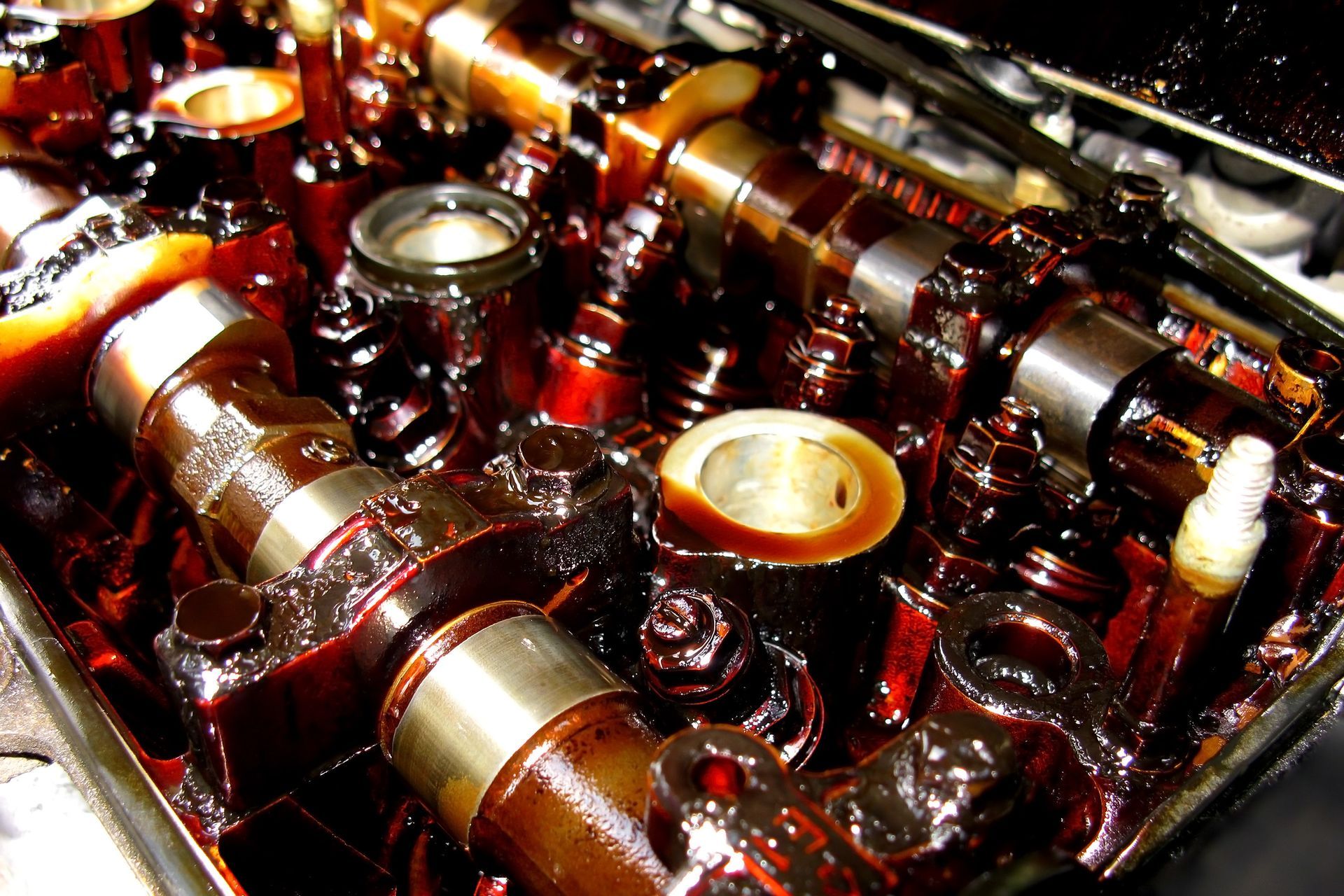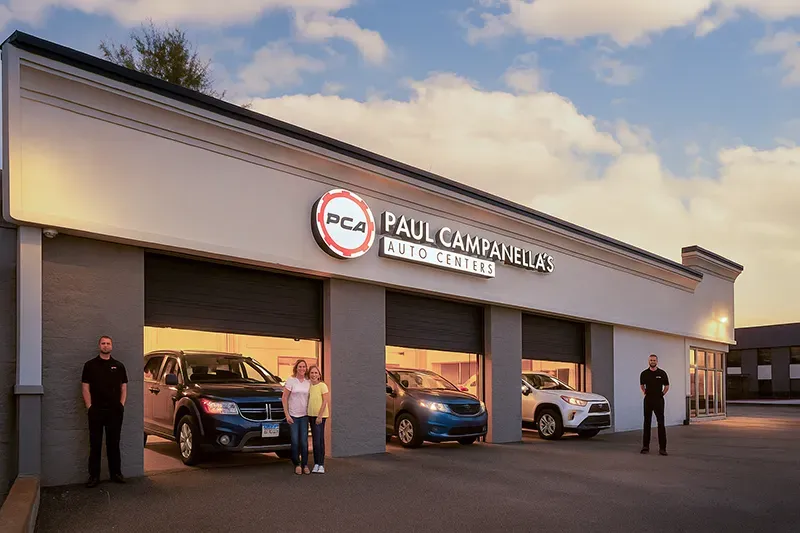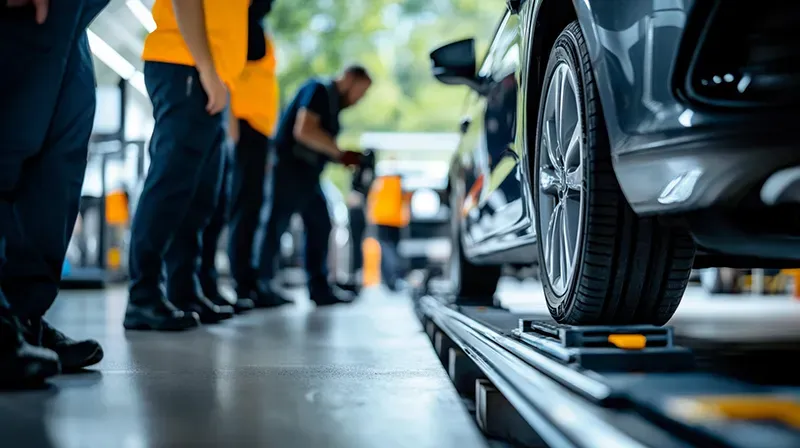When Should You Replace a Tire Instead of Repairing It?
There are several reasons why you might need tire repair:
1. Puncture or damage: A puncture or damage to your tire can cause it to deflate or lose pressure, which can make it difficult or unsafe to drive your vehicle. Repairing the puncture or damage can help restore the tire's functionality.
Did you know? Paul Campanella’s Auto & Tire Center provides free tire plugs! Schedule your visit with us here .
2. Wear and tear: Over time, tires can wear down or become damaged due to normal use or exposure to harsh road conditions. Repairing any damage or wear can help extend the life of your tires.
3. Safety concerns: If your tires are damaged or have worn-down treads, they can become unsafe to use. Repairing any issues with your tires will help ensure they are safe for use on the road.
4. Cost savings: Repairing a tire is often less expensive than replacing it, so if you can repair the tire rather than replacing it, you may save money in the long run.
Overall, tire repair helps keep your vehicle safe, extend the life of your tires, and save you money.
You should replace a tire when it is no longer safe to use due to wear or damage. Here are some signs it may be time to replace a tire:
1. Low tread depth : Tires with worn-down tread can lose traction and become unsafe, especially in wet or slippery conditions. To check if your tire tread is too low, you can use a tread depth gauge or do the penny test.
- Tread depth gauge: A tread depth gauge is a tool designed to measure the depth of the grooves in your tire tread. Simply place the gauge in the groove of your tire and read the depth. If the depth is below the minimum safe depth, it's time to replace the tire.
- Penny test: The penny test is a quick and easy way to check your tire tread depth. Place a penny into the tread grooves with Lincoln's head upside down and facing you. If you can see the top of Lincoln's head, your tire tread is too low and it's time to replace the tire.
The minimum safe tread depth for your tires varies by state and country, but a general rule of thumb is that the minimum safe tread depth is 4/32 of an inch (1.6 millimeters). However, it's a good idea to replace your tires before they reach this point for optimal safety on the road. Additionally, if you notice uneven tire wear or damage to the tire, it's important to have it inspected by a professional.
2. Damage to the sidewall: If you notice damage to your tire sidewall, it's important to have it inspected by a professional as soon as possible. Sidewall damage can weaken the tire and increase the risk of a blowout, which can be very dangerous while driving.
Common causes of sidewall damage include hitting curbs or potholes, running over debris on the road, or wear and tear over time. Signs of sidewall damage can include bulges, cuts, punctures, cracks, or any other abnormalities on the sidewall of the tire.
If you notice any signs of sidewall damage, you should have your tire inspected by a professional mechanic. They can determine if the tire can be repaired or if it needs to be replaced entirely.
It's important to keep your tires in good condition and replace them when necessary to ensure your safety on the road. Regularly inspect your tires for signs of damage, and have them professionally inspected and maintained as recommended by the manufacturer.
3. Punctures or cuts: A puncture or cut in the tire may cause it to lose air pressure, which makes the tire unsafe. A puncture can be repaired if it is small and located in the tread area, but if the damage is severe or on the sidewall, the tire should be replaced. If you suspect that your tire has a puncture, you should act right away to avoid any potential safety hazards while driving. Here are some steps to take if you think you have a punctured tire:
- Check for signs of a puncture: Look for any visible signs of a puncture, such as a nail or screw in the tread area of the tire. You may also notice a hissing sound or a sudden drop in air pressure.
- Check the tire pressure : Use a tire pressure gauge to check the air pressure in the affected tire. If the pressure is significantly lower than the recommended pressure, you may have a puncture.
- Do not remove the object: If you can see a nail or screw in the tire, do not remove it. Removing the object may cause the tire to rapidly deflate, which could be dangerous if you are driving at high speeds.
- Put on the spare tire : If you have a spare tire, it's a good idea to put it on the vehicle as soon as possible. Make sure to follow the manufacturer's instructions for changing a tire, and drive to an auto repair shop to have the punctured tire repaired or replaced.
It's important to address the punctured tire as soon as possible to ensure your safety on the road. Regularly inspect your tires for signs of punctures and have them professionally maintained and repaired as recommended by the manufacturer.
4. Age: Tires can deteriorate over time, even if they have plenty of tread left, so it's important to know how to determine if your tires are too old. Here are some signs that your tires may be too old and need to be replaced:
- Check the date code: Every tire has a date code stamped on the sidewall that indicates it is more than six years old should be inspected by a professional.
- Check for cracking: Over time, rubber can dry out and crack, which can weaken the tire and increase the risk of a blowout. Check the sidewalls and the tread for any signs of cracking or dry rot. If you notice any cracking, the tire should be replaced.
- Check for bulges or blisters: Bulges or blisters on the sidewall of a tire can indicate that the tire is weakened and at risk of a blowout. If you notice any bulges or blisters, have the tire inspected by a professional mechanic or tire specialist.
- Pay attention to the handling: If your tires are old and worn out, you may notice that your vehicle doesn't handle as well as it used to. You may experience more noise, vibration, or a rougher ride. If you notice any changes in handling, have your tires inspected by a professional.
- Check the tread depth: While tread depth is not the only indicator of tire health, it's still important to regularly check your tires' tread depth. Tires with less than 2/32 of an inch (1.6 millimeters) of tread depth should be replaced, regardless of their age.
It's important to replace your tires before they become too old or worn out to ensure your safety on the road. Regularly inspect your tires for signs of wear and aging, and have them professionally maintained and replaced as recommended by the manufacturer.
5. Uneven wear: Uneven tire wear can be a sign of several issues, such as misaligned wheels, improperly inflated tires, or worn suspension components. Here are some signs to look for when determining if your tires are wearing unevenly:
- Check the tire tread: Uneven tire wear can cause certain areas of the tire tread to wear down faster than others. Check the tread of each tire to see if there are any areas that are significantly more worn down than others. You may notice that the tread is more worn on one side of the tire than the other.
- Look for bald spots: Uneven tire wear can also cause bald spots to develop on the tire tread. These bald spots may be more prominent on one side of the tire than the other.
- Pay attention to handling: If your tires are wearing unevenly, you may notice that your vehicle doesn't handle as well as it used to. You may experience more noise, vibration, or a rougher ride. You may also notice that the vehicle pulls to one side while driving.
- Check the tire pressure: Improperly inflated tires can cause uneven wear. Check the tire pressure of each tire to make sure they are inflated to the recommended level.
- Have the tires inspected: If you suspect that your tires are wearing unevenly, have them inspected by a professional mechanic. They can diagnose the problem and recommend a course of action, such as tire rotation, wheel alignment, or suspension repairs.
Regularly inspecting your tires for signs of uneven wear and having them maintained and repaired will help ensure they last longer and provide better performance on the road.
Shopping for new tires? Our service team at Paul Campanella’s Auto & Tire Center will match you with tires that fit your vehicle and needs. Schedule your visit with us here .
Here are some signs of tire wear and tear:
1. Low tread depth: The tread on your tires helps provide traction and grip on the road. If the tread is worn down, it can make it difficult to control your vehicle in wet or slippery conditions. You can check your tire's tread depth by using a tread depth gauge or by looking for the wear indicator bars on the tire.
2. Cracks or cuts: Over time, tires can develop cracks or cuts in the sidewall or tread. These can weaken the tire and increase the risk of a blowout or puncture.
3. Bulges or bubbles: A bulge or bubble on the sidewall of your tire can indicate internal damage or weakness, which can lead to a blowout.
4. Uneven wear: Uneven wear on your tires can be a sign of misalignment, improper inflation, or suspension issues. This can affect your vehicle's handling and performance.
5. Vibration or noise: If you feel a vibration or hear unusual noise coming from your tires while driving, it could be a sign of wear or damage.
If you notice any of these signs of wear and tear, it’s important to have your tires inspected by a professional. Depending on the severity of the wear, the tires may need to be repaired or replaced to ensure safe driving. Regular tire maintenance, including proper inflation and rotation, can help to extend the life of your tires and prevent premature wear and tear.
Here are some tips on how to avoid tire repair and premature tire replacement:
1. Regular tire and vehicle maintenance: Regular maintenance is key to keeping your tires in good condition. This includes checking tire pressure, inspecting for damage or wear, and rotating your tires regularly. Keeping your tires properly inflated helps prevent uneven wear and reduce the risk of blowouts and punctures. Check your tire pressure regularly and inflate to the recommended level for your vehicle. Rotating your tires regularly helps distribute wear more evenly across all four tires, which can extend their overall lifespan.
Regular maintenance of your vehicle, including alignment and suspension checks, helps prevent uneven wear and other issues that can shorten the life of your tires.
2. Avoid hazards: Try to avoid driving over debris or potholes, which can cause punctures or other damage to your tires. Rough or damaged roads can cause additional stress on your tires, leading to wear and damage. If possible, avoid driving on poorly maintained roads.
3. Drive defensively: Defensive driving can help you avoid accidents that could damage your tires. Rapid acceleration, hard braking, and sharp turns can all put additional stress on your tires, which can lead to wear and damage. Keep a safe distance from other vehicles, avoid sudden stops or turns, and slow down in hazardous road conditions.
Drive responsibly to help extend the life of your tires.
4. Use proper tires: Make sure you are using the right type of tire for your vehicle and driving conditions. Using tires that are designed for your vehicle and the conditions you will be driving in help reduce the risk of damage or wear.
5. Replace worn or damaged tires: If your tires are worn down or damaged, it is important to replace them as soon as possible. Driving on worn or damaged tires can be dangerous and can lead to further damage or issues.
6. Avoid overloading: Overloading your vehicle can put additional stress on your tires, which may lead to premature wear and damage. Make sure to stay within your vehicle’s recommended weight limit.
By following these tips, you can help reduce the risk of needing tire repair and keep your tires in good condition for longer.
If you are concerned about your tire health, contact our service team via phone call or schedule a visit online. We provide free digital courtesy inspections, which include tire inspections, for your vehicle every visit. Our ASE-certified technicians also provide free tire rotations with every oil change, and our customers love our complimentary tire plugs!









